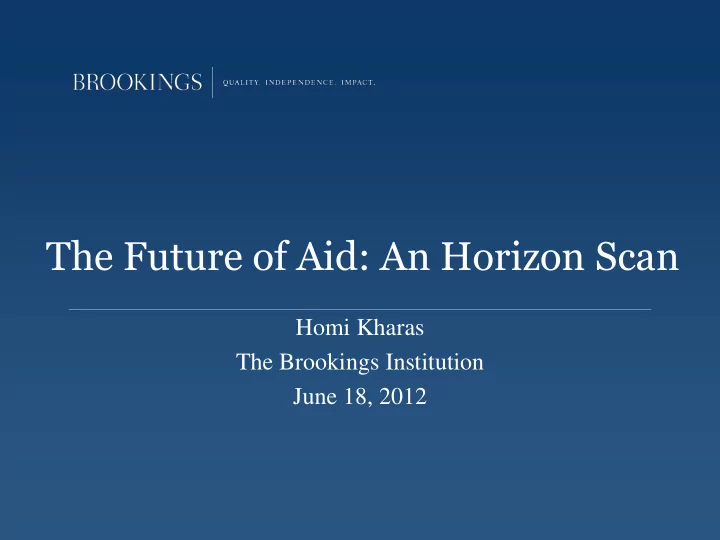

The Future of Aid: An Horizon Scan Homi Kharas The Brookings Institution June 18, 2012
1 A Changing Development Landscape • The World is Changing » Uncertainty and crises » Convergence » Fragility » Inequality » Africa • Development Needs are Shifting » Financing the Global Poverty Gap » Funding Infrastructure » Targeting Countries • So is the Environment for Bilateral Donors » Emerging Economy Donors » Private Philanthropy • So who will need to change? » Aid Agency Relevance
2 The Changing World: Greater Volatility in Capital Flows 400 350 Developing Asia Capital flows, net (US dollar, billions) Latin America and the Caribbean 300 Sub-Saharan Africa 250 200 150 100 50 0 1990 1995 2000 2005 2010 -50 Source: IMF WEO Database, April 2012
3 The Changing World: Higher Food and Energy Price Volatility 300 Food Price Index Fuel (Energy) Index 250 200 2005=100 150 100 50 0 Source: IMF Primary Commodity Prices Notes: Food Price Index, includes Cereal, Vegetable Oils, Meat, Seafood, Sugar, Bananas, and Oranges Price Indices; Fuel (Energy) Index, includes Crude oil (petroleum), Natural Gas, and Coal Price Indices
4 The Changing World: Convergence towards Middle Income Countries Income Classification 1990 2010 2025 Low Income Number of countries 51 35 25 Total population (millions) 3074 793 712 GDP per capita (USD constant 2000) 362 300 299 Number of poor, millions (under 2 dollars a day) 2079 449 315 Middle Income Number of countries 86 110 99 Total population (millions) 1083 4976 3905 GDP per capita (USD constant 2000) 2934 2008 2121 Number of poor, millions (under 2 dollars a day) 162 672 237 Memo: Developing country GDP growth 2010-2016: 7.72% Developing country GDP, current prices, 2011: $25.1 tn. Developing country GDP 2025: $71 tn.
5 The Changing World: No Poverty Reduction in Fragile States 2500 Number of poor people, millions (under 2 2000 dollars a day) 1500 Non-fragile Fragile Total 1000 500 0 1990 1995 2000 2005 2010 2015 2020 2025
6 The Changing World: Inequality Threatens Social Stability Better Worse No Change East Asia and Pacific 6 6 0 Sub-Saharan Africa 8 7 5 Latin America and Caribbean 12 2 3 South Asia 4 0 1 Europe and Central Asia 12 6 6 Middle East and North Africa 2 0 1 TOTAL 44 21 16 • Change in Gini coefficient by more than one percentage point between most recent survey and five-year previous survey pre-2006. • Skills premia, urban bias, falling labor share in GDP, labor-saving technology, scale economies, can create growth-inequality trade-offs.
7 The Changing World: Poverty in Africa Number of poor (under Total net official 2 dollars (2005 PPP) a development assistance day ) (constant 2009, millions) 1990 2010 2025 1990 2010 2025 Africa 490 46,655 359 508 33,413 ? Rest of the 1885 613 73 37,620 49,421 ? world
8 Development Needs: Financing the Global Poverty Gap 3.5% 3.0% 2.5% Poverty gap as a share of global GDP 2.0% Resources needed to bring poverty gap of countries to 1 percent of GDP, as a 1.5% share of DAC GDP 1.0% 0.5% 0.0% 1990 1995 2000 2005 2010 2015 2020 2025
9 Development Needs: Funding the Infrastructure Gap • G24 estimate: additional financing of $1 trillion per year on top of existing flows of $0.8-0.9 trillion, with 80 percent in low and lower middle income countries • ADB estimate of $8.22 trillion over 10 years only for Asia (35-50% of global total) • Only 20% invested by the private sector
10 Development Needs: Targeting Countries Africa, Fragile, High poverty gap, Low Income Africa, Fragile, High poverty gap Africa, High poverty gap Burkina Faso Angola Ghana Central African Republic Cameroon Lesotho Chad Cote d'Ivoire Mauritania Congo, Dem. Rep. Nigeria Senegal Ethiopia Sudan Zambia Kenya Liberia Africa, Low Income, High poverty gap Fragile, High poverty gap Malawi Benin Uzbekistan Niger Gambia, The Yemen, Rep. Sierra Leone Madagascar High poverty gap, Low Togo Mali Income Uganda Mozambique Cambodia Zimbabwe Rwanda Kyrgyz Republic Tanzania Low Income, Africa None Africa, Low Income, Fragile None Africa, Fragile Low Income, Fragile, High poverty gap None Bangladesh Haiti Fragile, Low Income Nepal None Tajikistan
11 Environment for Bilateral Donors: Private Philanthropy • Private philanthropic flows could be in the range of $60-75 billion per year • Mobile money and other new technologies and management structures are allowing the private sector to scale up (Kiva, Give Direct) • A far broader range of NGO and private service delivery and livelihoods projects are now available • Will public service delivery be disintermediated by these trends?
12 Environment for Bilateral Donors: Emerging Economy Donors • Non-DAC ODA is about $15 billion per year in aid and growing rapidly • BRIC countries alone have an estimated $750 bn in FDI abroad • South-South trade growing rapidly and is a powerful instrument of development cooperation • Coherent approaches to growth and development preferred to project approaches • “How to” experiences preferred to “what to” prescriptions • Whole of government approaches
13 Who Needs to Change: Aid Agency Relevance Japan Spain Italy Germany France Greece UN (Select Agencies) Korea IDA EC Australia Austria IDB Special Norway United Kingdom Netherlands New Zealand Belgium IMF (Concessional Trust Funds) IFAD Switzerland Luxembourg AsDB Special Funds Ireland GEF USA AfDF Portugal Denmark Finland Sweden GFATM Canada GAVI 0 0.5 1 1.5 2 2.5
Recommend
More recommend